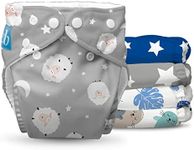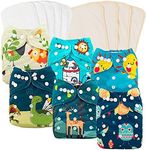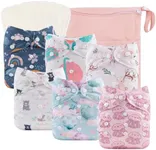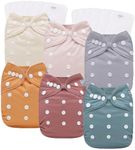Buying Guide for the Best Reusable Diapers
Choosing reusable diapers can be a great decision for both your baby and the environment. The process involves understanding your baby's needs, your lifestyle, and how much time you can dedicate to washing and maintaining the diapers. It's important to look at the different types, materials, and features to ensure comfort, ease of use, and effectiveness. By focusing on the key specifications, you can find a reusable diaper that fits your baby well, is easy for you to manage, and keeps your baby dry and comfortable.Type of DiaperReusable diapers come in several types, such as all-in-ones, pocket diapers, prefolds, and fitted diapers. This specification refers to how the diaper is constructed and how you use it. All-in-ones are the most similar to disposable diapers and are easy to use, while pocket diapers have a pocket for absorbent inserts, allowing you to adjust absorbency. Prefolds and fitted diapers require a separate waterproof cover but can be more customizable. If you want simplicity and convenience, all-in-ones or pocket diapers are a good choice. If you prefer flexibility and potentially lower cost, prefolds or fitted diapers might suit you better.
MaterialThe material of a reusable diaper affects absorbency, comfort, and how easy it is to clean. Common materials include cotton, bamboo, microfiber, and hemp. Cotton is soft and breathable, bamboo is highly absorbent and gentle on sensitive skin, microfiber dries quickly but can sometimes cause irritation, and hemp is very absorbent but slower to dry. If your baby has sensitive skin, natural fibers like cotton or bamboo are a good choice. If you need something that dries quickly, microfiber might be better, but always use a liner to protect the skin.
AbsorbencyAbsorbency refers to how much liquid the diaper can hold before it needs to be changed. This is important for keeping your baby dry and preventing leaks. Diapers with higher absorbency are better for overnight use or longer outings, while standard absorbency is usually fine for daytime use and frequent changes. If your baby is a heavy wetter or you want to use the diaper overnight, look for options with extra inserts or layers. For regular daytime use, standard absorbency should be sufficient.
Size and AdjustabilitySize and adjustability determine how well the diaper fits your baby and how long you can use it as your baby grows. Some diapers come in specific sizes, while others are 'one-size' with adjustable snaps or Velcro to fit a range of ages and weights. Adjustable diapers can save you money and hassle as your baby grows, but sized diapers may offer a more tailored fit, especially for newborns. If you want a diaper that grows with your baby, choose an adjustable one-size option. If you prefer a perfect fit at each stage, consider sized diapers.
Ease of CleaningEase of cleaning refers to how simple it is to wash and dry the diaper. Some diapers have multiple parts that need to be separated for washing, while others are all-in-one pieces. Materials like microfiber dry quickly, while natural fibers may take longer. If you want to minimize laundry time and effort, look for diapers that are easy to rinse, wash, and dry, and consider how many parts need to be assembled after washing.
Closure TypeClosure type refers to how the diaper fastens on your baby. The most common types are snaps and Velcro (hook and loop). Snaps are durable and less likely to wear out over time, but can be a bit trickier to fasten, especially with a wiggly baby. Velcro is quick and easy to use but may lose its stickiness after many washes. If you want speed and convenience, Velcro might be best, but for long-term durability, snaps are a good choice.
Leak ProtectionLeak protection is about how well the diaper prevents leaks, which depends on the fit, the quality of the leg elastics, and the waterproof outer layer. Good leak protection is essential for keeping your baby comfortable and your home clean. If your baby is very active or you need a diaper for overnight use, look for strong leg elastics and a reliable waterproof cover. For everyday use, standard leak protection is usually enough.














